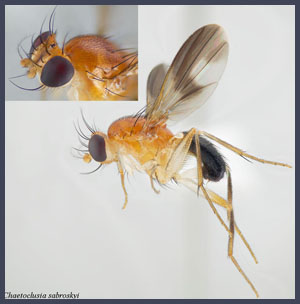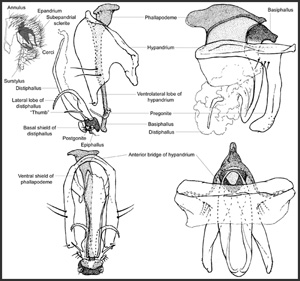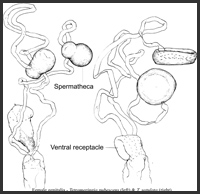| |
Introduction
Adult Characteristics
 General. Clusiids are characteristically slender acalyptrate flies usually 2.5-6.0 mm in length, most readily identified by an angulate extension on the outer margin of the pedicel, a dorsoapical arista (dorsobasal in similar families) on an orbicuar first flagllomere, a complete subcosta, one subcostal break, one pair of vibrissae, and five or fewer fronto-orbital bristles. Most species are yellow with a brown to black pattern, but several species are entirely pale (some Sobarocephala Czerny), and a number of taxa are predominantly brown to black (many Heteromeringia Czerny and Craspedochaeta Czerny). General. Clusiids are characteristically slender acalyptrate flies usually 2.5-6.0 mm in length, most readily identified by an angulate extension on the outer margin of the pedicel, a dorsoapical arista (dorsobasal in similar families) on an orbicuar first flagllomere, a complete subcosta, one subcostal break, one pair of vibrissae, and five or fewer fronto-orbital bristles. Most species are yellow with a brown to black pattern, but several species are entirely pale (some Sobarocephala Czerny), and a number of taxa are predominantly brown to black (many Heteromeringia Czerny and Craspedochaeta Czerny).
Chaetotaxy. There are three to five (sometimes two) fronto-orbital bristles; the anterior bristle is sometimes inclinate, and if there are four or five fronto-orbitals, the third from the back is sometimes inclinate and proclinate (Craspedochaeta). Convergent interfrontal bristles are sometimes present. The ocellar and postvertical bristles are divergent and usually small to absent. On the thorax, there are one to three dorsocentral bristles, one postpronotal, two notopleurals, two or three intra-alars (the presutural intra-alar is sometimes absent), one or two intrapostalar bristles, and one strong anepisternal and katepisternal bristle; a presutural intra-alar and/or a prescutellar acrostichal is sometimes present. The mid and hind tibiae sometimes have one or two dorsal preapical bristles. The subcosta is complete and a subcostal break is present, although this break is indistinct in most Clusiodinae.

 ♂ Genitalia. Externally, clusiid male genitalia are composed of a dome-shaped epandrium, well developed surstyli, two cerci that are confluent basally, and an 'annulus' comprised of sternites 6-8. Internally, the genitalia are made up of a subepandrial sclerite, a hypandrium with three lateral setae and a pair of 'arms' that attach to the subepandrial sclerite, a rod-like phallapodeme, a ring-like basiphallus, a fin-like epiphallus, a short to long distiphallus, one pair of lateral lobes at the base of the distiphallus, a single ejaculatory apodeme, and one pair of pregonites and postgonites. This ground-plan is highly modified in the Clusiodinae excluding Allometopon Kertesz, as the postgonite, epiphallus, and lateral lobes of the distiphallus are absent, the pregonite is enlarged and fused to the hypandrium, the phallapodeme is short and variably modified, and the hypandrial arms are partly attached to the annulus (Lonsdale & Marshall, 2006). The phallus itself may also be highly modified, being either large and sac-like, extremely long and coiled, or atrophied to absent. ♂ Genitalia. Externally, clusiid male genitalia are composed of a dome-shaped epandrium, well developed surstyli, two cerci that are confluent basally, and an 'annulus' comprised of sternites 6-8. Internally, the genitalia are made up of a subepandrial sclerite, a hypandrium with three lateral setae and a pair of 'arms' that attach to the subepandrial sclerite, a rod-like phallapodeme, a ring-like basiphallus, a fin-like epiphallus, a short to long distiphallus, one pair of lateral lobes at the base of the distiphallus, a single ejaculatory apodeme, and one pair of pregonites and postgonites. This ground-plan is highly modified in the Clusiodinae excluding Allometopon Kertesz, as the postgonite, epiphallus, and lateral lobes of the distiphallus are absent, the pregonite is enlarged and fused to the hypandrium, the phallapodeme is short and variably modified, and the hypandrial arms are partly attached to the annulus (Lonsdale & Marshall, 2006). The phallus itself may also be highly modified, being either large and sac-like, extremely long and coiled, or atrophied to absent.
 ♀ Genitalia. The female genitalia are much simpler than those of the male, being comosed of a ventral receptacle and one pair of spermathecae. These structures are weakly sclerotized and difficult to examine, and staining is often necessary. In the Clusiinae and Sobarocephalinae, the spermathecae are often simple and spherical, but in the Clusiodinae, they are longitudinally segmented and sometimes telescoped and heavily pigmented. The ventral receptacle is usually sac-like and recurved, but this generalized form is variably modified in several genera. ♀ Genitalia. The female genitalia are much simpler than those of the male, being comosed of a ventral receptacle and one pair of spermathecae. These structures are weakly sclerotized and difficult to examine, and staining is often necessary. In the Clusiinae and Sobarocephalinae, the spermathecae are often simple and spherical, but in the Clusiodinae, they are longitudinally segmented and sometimes telescoped and heavily pigmented. The ventral receptacle is usually sac-like and recurved, but this generalized form is variably modified in several genera.
|
|
 |











 General. Clusiids are characteristically slender acalyptrate flies usually 2.5-6.0 mm in length, most readily identified by an angulate extension on the outer margin of the
General. Clusiids are characteristically slender acalyptrate flies usually 2.5-6.0 mm in length, most readily identified by an angulate extension on the outer margin of the 

